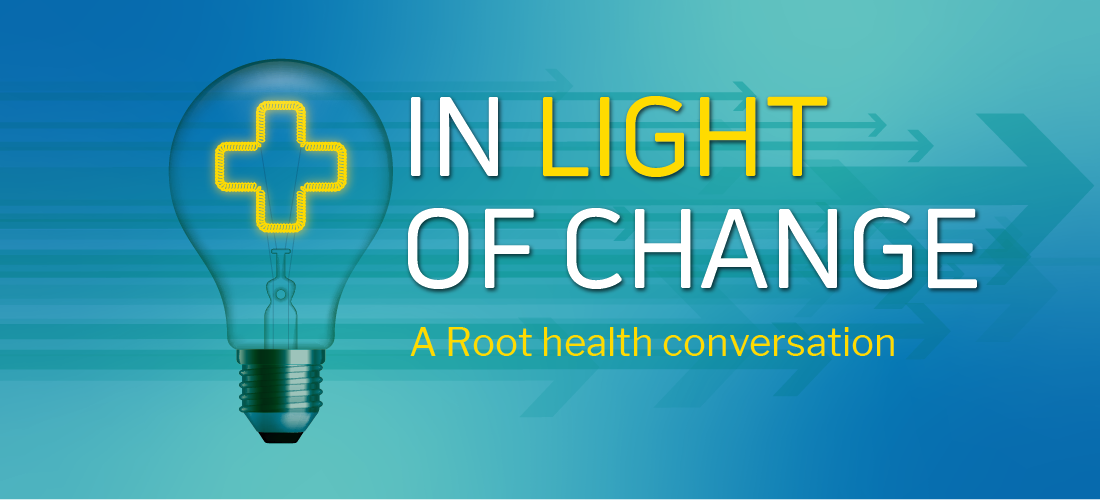Our health industry expert and Managing Director Kalen Stanton continues this blogcast (podcast + blog), In Light of Change, and builds further on the why of change. In this episode, we’re tackling the very current topic of leading during a crisis. We want to share insight on what health care leaders – and leaders in all industries – should be doing to help guide their people during this unprecedented and very worrisome time.
Listen to the full conversation here.
What you’ll hear and read:
- You need to let go of old definitions of success
- Speed becomes a critical factor for truth – whether it’s sharing what you know or what you don’t know
- People will tolerate what you say, but ultimately, they will act on their own conclusions
- Authenticity is worth more than promises
- You have to be extra clear about what the hard lines, guidelines, and no lines are for the foreseeable future
- While safety may be the highest priority, fun is a critical element as you shift from old habits to new ones in your culture
- A gauge and guide for maintaining strategic focus through your crisis response
Leading Through a Crisis
Kalen: Today we’re in a different climate across all industries (and even the world), which you are experiencing with increasing speed and intensity. And that is – we’re in a state of crisis.
We’re delighted to have Rich Berens, Root CEO and Chief Client Fanatic, as well as our head of Human Resources and Culture, Karen Stigall, to share perspectives on how our clients – across industries – are navigating the COVID-19 crisis and how we are talking about it within Root.
How can you best communicate during a time of crisis and engage people while ensuring your mission and purpose remain at the front of what you’re doing?
Rich: What we’re seeing with our clients right now is that the level of crisis depends on the industry. For example, if they’re in hospitality, a hotel or restaurant chain, their business is decimated. In other industries, there is concern for safety, but the revenue streams aren’t fully impacted. Regardless of industry, we’re seeing great anxiety. Leaders need to ask themselves, “How do you embrace the anxiety rather than fight it?” Leaders must acknowledge the anxiety because it’s very real for people in both their personal and professional lives.
Our purpose at Root is to invigorate the power of human beings to make a difference. We’re working hard to meet people where they are because then we have a chance to authentically engage and work through this together as a business.
Karen: Start with the understanding of where people are coming from and then transitioning into the message or information you want to share. This is an important way for us to let our people know we are in it with them.
In health care in particular, we’re hearing that our clinical team members and professionals, physicians, nurses, etc., need to know that leaders have their backs.
Rich: In many ways we’ve got true heroes in the health care sector right now, stepping into the places of danger, working longer hours, and doing all of the right things, which is really important. For leaders, it’s amazing how recognizing that, reiterating that – even just for five minutes in a meeting or a quick huddle or even a simple three-, four- or five-minute reminder can be the fuel at the beginning of the day to give people (including non-clinical) energy to keep going and that their leaders are in it with them.
Defining Success During a Crisis
Kalen: For some, success is defeating an enemy, which could be a disease. For others, success could be keeping our people safe. It could be fulfilling our mission. Or even our strategy. How should we define success during a time of crisis?
Rich: At Root we said, “Just to be very clear, our number one priority is safety – the safety of everybody regardless of what that costs us. Then number two is business continuity. And so, we will make sure the enterprise ultimately survives and then thrives, and then we’re going to be focused on jobs, in that order.”
One piece that’s essential for leaders, and for all of us in a situation like this, especially when your industry is impacted quite a bit, is you have to let go of old definitions of what winning looks like.
For many of us, the goals, metrics, and targets we had four weeks ago are now irrelevant in a world that has changed profoundly. And so, you got to let go of those things and redefine a true north for the moment – one that’s authentic, that’s based in reality, and that people can rally around and understand. Leaders must also be really clear on the new goals.
Karen: Rich did a really nice job of laying this mindset out at our initial all-company meeting [specific to COVID-19], which allowed all of our leaders, managers, and individuals to really think about what they could do from their individual positions to achieve those new goals. Whether it was figuring out how we get all of our people to be able to work productively and effectively from home or thinking about how we support our clients that are also going through this situation with us.
Everyone was able to understand what we were trying to achieve and begin to make progress with that, even if it will shift over the upcoming days and weeks.
Rich: And you can’t promise anything. All you can do is be honest. Here’s what we see; here’s what we need everybody to be doing; and we’ll be agile, truthful, and authentic. But it’s amazing how people will go with you and fight the good fight if they know that’s all coming from an authentic place.
Kalen: In a crisis situation, there is a much more rigid “do and do not” than we might typically have. How do you draw between hard lines, guidelines, and no lines when you’re communicating about what that path is and how managers and individuals should know when they need to stay on the path or use their best judgment?
Rich: This is something organizations struggle with in normal times, and it’s even more of a challenge now. In many ways, what happens in times like these is that we talk about the framework of hard lines, guidelines, and no lines.
- Hard lines meaning “Where are you non-negotiable? These things need to happen.”
- Guidelines meaning “Here are certain principles and then use your judgment within those.”
- No lines meaning “We’re not telling you what to do. You figure it out because it’s happening on the front line or where your job is.”
In times like these, it’s essential that you’re crystal clear on the hard lines and the non-negotiables, and sometimes those just need to be provided from the top down because speed is required. Now that said, there’s also a danger. For some people, everything becomes a hard line. “Well, unless I get clear orders, I’m not acting on anything.” And then others will be so consumed by wanting to make a difference that they almost run around frantically kind of doing just about anything.
Karen: There also seems to be even more of a need to know what different groups or work streams are working on to address the crisis. For example, we [at Root] have one consultant who sent a note and listed off eight different things within two days that people had pulled her to or surfaced as opportunities for her to help out. And so, in an absence of an overarching view or some of those hard lines or those priorities, we can leave individuals to blindly figure it out on their own or seeing that all eight of those things are important.
What to Watch Out for During this Crisis
Kalen: Are there any “watch outs” or opportunities you’ve seen with organizations that are shifting to a remote or virtual working environment?
Rich: This is a time to break your normal habits because they likely don’t work or don’t apply right now. You want to have more frequent, quick connects. We see a lot of clients have huddles daily or every other day. Sometimes they’re only 10 or 15 minutes, and previously these meetings may have lasted two to three hours and occurred every two or three weeks.
This format is needed for the short term, but there might be some things that stick around more permanently. The way we connect and the way we talk to one another is going to change for good most likely, at least to a degree. And we’re learning habits and norms, a lot of them for the better, that are going to stay with us after this crisis is over.
Karen: Even team chats are becoming a way for people to recreate office banter. Our team of proofing and design consultants has a new group chat so they can continue the casual conversation that would happen if someone walked by your desk. So even if the team isn’t in the same physical location, they can still feel connected. Ask your team, “How are you taking care of yourself?” “What did you get to do for fun yesterday?” “What are you focused on today? Anything you need help with?” I think this type of informal chatting and checking in will continue to live on past this time.
Rich: One dark side or downside of this to be aware of as a leader is social isolation and loneliness. We talk about social distancing, and that’s probably going to be “the” term of 2020, but leaders need to be thinking of people who are single in an apartment. These folks haven’t talked to somebody in four or five days and they’re struggling to some degree on how to process this, and they don’t know how long this is going to go.
Leaders and team managers need to be extra sensitive to how people are feeling. People’s environments have changed significantly, not just their job and what’s happening there, but their personal life, and that can be very stressful on folks.
Elements of fun can be quick and small things, but they can make a big impact. We had a Zoom meeting yesterday and as an icebreaker we gave everyone two minutes to find a hat and put it on. It was hilarious and changed the entire mood of that conversation. I was on a different call at the end of the day and they said, “We’re going to take 15 and end the call with a little cocktail ‘hour’ while we’re all looking at each other on screen.” And those things make a big difference.
What We’re Doing at Root
Kalen: How are we defining success and what are we doing at Root during this time to make a difference?
Rich: At the highest level, we just want to be there for our clients in however they need us. A couple of clients have said that while we had all this work planned, give us two weeks because we have other things we need to focus on instead. In response, we’re saying, “Absolutely; if you need us in any way, shape, or form, just let us know.” So it can take that dimension. For other clients, priorities have changed, and they need help with crisis management. Ultimately, we want to do our part by being able to pivot and just being there for our clients.
We want our clients to look back and say in our moments of biggest need or biggest change or biggest impact, they knew they could count on Root. They were there for us, and we know [Root] had my best interest at heart. And that’s what makes them a great partner.
How are you leading your people through this crisis? Gauge your leadership blind spots using this 10 Musts for Leading Through a Crisis Guide and send Kalen and the team a note here for additional tips on how you can successfully navigate today’s challenges in your organization.









